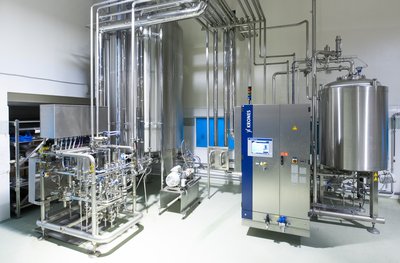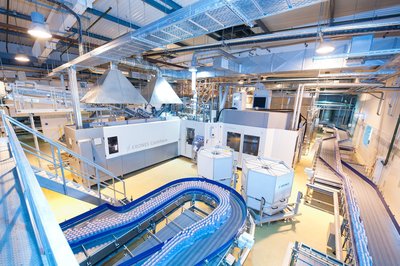Processing and bottling Pulpy orange juice
Wednesday, 07 March, 2012
Still beverages with a pulp content are finding progressively more adherents among consumers worldwide. In 2010, Coca-Cola’s chunky fruit juice Pulpy was on sale in 14 different nations; by 2011 it was already being produced and sold on 25 national markets. Beverages featuring fruit chunks are regarded as the paramount drivers for future global growth in the fruit juice segment.
For the premiere of bottling Pulpy at its Istra plant in Russia, Coca-Cola HBC Eurasia selected inline blending with aseptic filling. Krones installed the new process technology required and integrated it into an existing PET-Asept line, whose filling technology was likewise modified. In the preceding year, the facility, which now has a total of five Krones lines, put its first Contipure system into operation.

When processing Pulpy, it’s vital to preserve the pulp from the beginning of the process to the end, and to only integrate monitoring and operator control elements into the system that are really necessary. On the basis of experience gained in other countries, Coca-Cola had several alternatives to choose from: hot-filling in a single-flow process; an aseptic process in single-flow mode; aseptic inline blending with a twin-flow process and single-flow filling; or a hot or cold twin-flow process both for product processing and bottling on a dual filler.
Aseptic inline blending offers good preservation of the pulp, excellent dosing accuracy and high line output. Inline blending means that pulp and juice are aseptically prepared separately and then bottled together. “The paramount goal was to make the operation as gentle on the product as possible and to minimise damage to the fruit cells,” said Coca-Cola HBC Eurasia’s Country Engineering Manager, Natalia Polozova. “We didn’t even consider the option of not filling the product aseptically.”

Coca-Cola already possessed three aseptic bottling lines from Krones that could be used for this process. The company decided on the inline blending process and selected the PET-Asept Line 1 for the modification project.
The project posed several challenges for Krones. During the retrofit job, interventions were required in some of the existing processes at Coca-Cola HBC Eurasia and in the Krones lines already in place. This required meticulous preparation and thorough planning. A three-week delivery deadline and a minimised commissioning timeframe upped the pressure further.
The kit was manufactured, tested at Krones and promptly delivered to site. All the deadlines stipulated by Coca-Cola had to be met so the product reached the Russian market in good time. The paramount priority was to ensure gentle handling of the product and minimise product losses.

The pulp is delivered frozen in 180 kg drums and is thawed for 24 hours before processing. When the slurry meets temperature and composition criteria, the product is released, heated in the pasteuriser, then cooled. The pasteuriser’s output is approximately 2 m3/h. Through cross-corrugated tubes, the slurry is gently heated in the shell-and-tube heat exchanger and delivered by screw-spindle pumps. Minimised distances, few changes of direction in the system and elimination of control valves in the product path ensure the product is handled gently. After the slurry has been heated and cooled again, it passes to the sterile tank.
Meanwhile, juice without chunks and pulp is heat-treated and held ready in a sterile tank. The tank incorporates an agitator that gently keeps the slurry homogeneous. A vapour seal supply system prevents the slurry from being baked onto the surfaces in the vapour seals of Krones’ aseptic EvoGuard double-seat valves. The aseptic blender mixes approximately one part of slurry to nine parts of juice.
The finished beverage is supplied to the filler. Retrofitting the requisite filling valves and agitators in the ring bowl ensures optimum filling of the finished beverage under aseptic conditions. Line 1 is used solely for bottling 450 mL Pulpy Orange at a speed of 42,000 bph. Two more Pulpy products are set to follow in 2013.
The blow-moulder/filler monobloc features a Contipure system, where the preforms are decontaminated using gaseous H2O2 at the Contiform in a treatment chamber. The H2O2 concentration and hot preforms ensure a high decontamination rate for both inside and outside of the preforms. The risk of preforms or bottles being recontaminated is reduced as treatment occurs directly downstream of the oven and the bottles are blow-moulded with filtered air.
“Coca-Cola HBC Eurasia is always keen to use the very latest technology, which in this case was Contipure,” said Polozova. “Contipure offers us a series of advantages. Firstly, we can do without the air conveyor, which means reduced bottle losses and elimination of air conveyor maintenance, plus enhanced microbiological quality without the risk of recontamination. Secondly, we save on space, reduce our energy consumption in terms of compressed air for the conveyors and of steam for the filling function, and we can handle container production and filling with one operator instead of two.”

The line comprises a Contiform S 20 with a Contipure module, a Modulfill filler with a Checkmat in a monobloc configuration, plus a Contiroll HS wraparound labeller, a Variopac Pro packer for multipacks and in terms of process technology, a Contiflow mixer and a Varioflash pasteuriser.
By modifying PET-Asept Line 1 to operate with inline blending, and by commissioning the Contipure system, Coca-Cola HBC Eurasia has successfully upgraded its Istra facility, and significantly strengthened its position on the important Moscow market for new sensitive beverages. Polozova says this is “a crucial step forward”.
In-house ginger processing for beverage maker
A ginger beer manufacturer reduces its supply risk by investing in pack-house technology to...
Tailor-made solutions for sliced meat on show at IFFA
At this year's IFFA in Frankfurt, the MULTIVAC Group will be showing its latest line...
Five ways emerging tech can help food and beverage manufacturers
As food manufacturers embrace new innovations, they must also navigate the complex landscape of...














